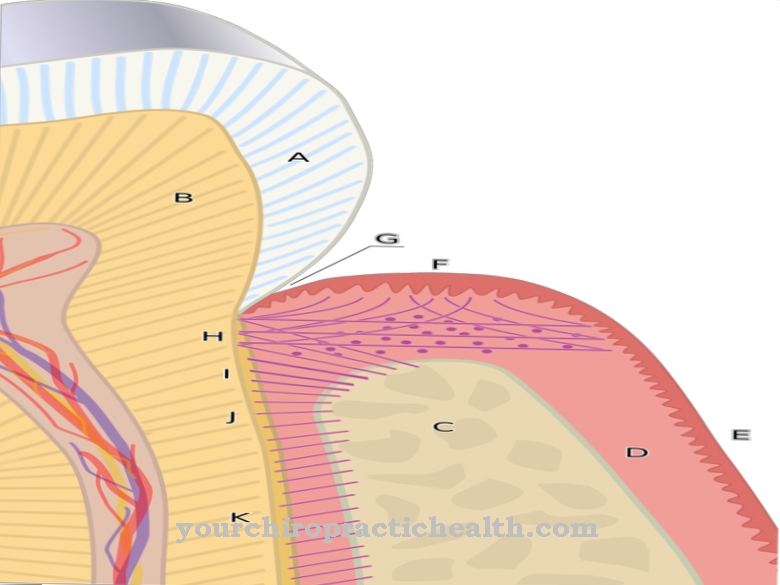As Vesicle gland is a paired accessory sex gland in men. They are located above the prostate and, together with the vas deferens, open into the urethra. The vesicle glands provide an alkaline, fructose-rich secretion for the ejaculate, which mobilizes the sperm and provides them with the energy they need for their active movement. Approx. 70% of the liquid content in the ejaculate comes from the vesicle glands.
What is the vesicle gland?
The pair of vesicle glands (vesicula seminalis), which used to be incorrectly called Seminal vesicles belong to the male accessory sex glands. The alkaline secretion that the vesicle glands synthesize is enriched with fructose.
About 70% of the fluid in the ejaculate comes from the vesicle glands. The secretion is used to create an alkaline environment for the sperm, which liberates them from their "acid rigor" and provides the sperm threads with the necessary energy in the form of fructose for their active movements. The two vesicle glands are located above the prostate between the back wall of the urinary bladder and the large intestine.
The secretion produced is usually exocytosed from the cells into the excretory duct, the ductus excretorius, and then via the ductus ejaculatorius into the ureter. The vesicle glands also synthesize other substances such as B. the protein Semenogelin, which encloses the sperm in a kind of gel matrix and prevents their premature maturation, which should only take place in the female genital tract before reaching the female egg.
Anatomy & structure
The vesicle glands have a longitudinally oval shape and are coiled in themselves. Their length is about 5 cm. The organs each consist of a single, multiply folded duct with a length of approx. 15 cm and a wide lumen.
The ducts at the lower end of the glands unite with the respective vas deferens, the ductus deferens, to form the so-called injection channel, the ductus ejaculatorius, which then opens into the urethra. The gland cells that synthesize the secretion usually transport the secretion via exocytosis to the outside into the extracellular matrix and further into the duct. This means that the secretion forms in vesicles within the cells. The vesicles fuse briefly with the cell membrane so that the secretion can then be released.
The epithelial cells that border the lumen have some smooth muscle cells that contract during ejaculation and the secretion so that the secretion can be properly expelled in accordance with sexual stimulation and at the same rhythm during ejaculation and can mix with the other parts of the ejaculate Press out suddenly from the lumina.
Function & tasks
The two vesicle glands are assigned to the accessory sex glands. Their main function is to synthesize certain substances and to mix them with the ejaculate in the right proportion when sexually aroused.
The secretion produced by the vesicle glands is in the alkaline range and raises the pH value of the ejaculate. This releases the sperm formed in the testicular tubules from their “acid rigidity” and stimulates them to move. So that the sperm do not run out of energy, the fructose contained in the ejaculate is available to them. However, their mobility is temporarily artificially slowed down by a protein to prevent them from maturing too early into fertile sperm.
The protein causes the sperm to be “packaged” in a kind of gel matrix that is only broken down and dissolved in the female genital tract. The subsequent maturation process (capacitation) includes a biochemical remodeling process on the cell walls of the seed threads. Above all, a glycoprotein coating on the cell walls is broken down.
The process of capacitation is mainly triggered by a certain hormone found in the cervical mucus. The vesicle glands are also responsible for protecting the sperm in the female genital tract from a possible immune attack. They therefore produce a hormone that weakens possible immune reactions in the vagina and thus protects the sperm on their way to the female egg.
Diseases
In rare cases, a malformation or a complete absence (aplasia) of one or both vesicle glands occurs during embryonic development, often accompanied by a malformation of the vas deferens.
The malformations can be traced back to mutations of the CFTR (cystic fibrosis transmembrane conductance regulator). Far more common is acute or chronic inflammation of the vesiculitis, which can be caused by infections with bacteria, viruses or fungi. Vesiculitis usually occurs in parallel with inflammation of the prostate. The disease is associated with pain in the lower abdomen, often with unspecific symptoms such as fever and chills.
Usually blood shows up in the ejaculate (semen). Diagnostic imaging methods such as transrectal ultrasound (TRUS), CT and MRT are suitable for differential diagnostic work-up and exclusion of prostate cancer or TB. The untreated course of vesiculitis can lead to inflammation of the bladder (cystitis), to an abscess in the vesicle gland or to urosepsis, bacterial blood poisoning that passes from the urogenital tract into the bloodstream via the urinary tract.
Rare diseases of the vesicle glands are primary or secondary cysts. Primary cysts are congenital and very rare. The secondary cysts that are acquired and are often associated with benign prostatic hyperplasia are far more common. Tumors in the area of the vesicles are also very rare and usually occur in younger men of sexually active age.
Typical & common venereal diseases
- Chlamydia (chlamydial infection)
- syphilis
- Gonorrhea (gonorrhea)
- Genital warts (HPV) (genital warts)
- AIDS
- Ulcus molle (soft chancre)
























.jpg)



